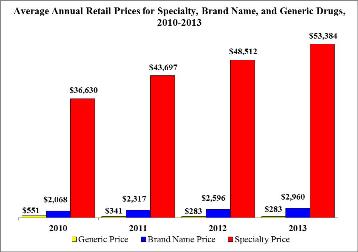WASHINGTON, DC — Retail prices for over one hundred widely used specialty prescription drugs surged skyward by nearly 11 percent in 2013, surpassing the median income of an American family, according to a new AARP Public Policy Institute (PPI) report issued today. The average annual cost of a specialty medication used on a chronic basis exceeded $53,000 in 2013. This cost was greater than the median U.S. household income of $52,250, more than twice the median income of $23,500 for people on Medicare, and almost three-and-a-half times higher than the average Social Security retirement benefit of $15,526 over the same time period.
“Specialty drugs are among the most expensive on the market, and are expected to be the fastest growing group of drugs over the next decade,” said Debra Whitman, PhD, AARP’s Chief Public Policy Officer. “These exorbitant prices and price increases can be financially disastrous, especially for people on fixed incomes. Americans cannot continue to absorb the astronomical costs associated with these products indefinitely.”
The AARP PPI report also found that specialty drug prices are considerably higher than other drug prices. In 2013, the average annual cost for specialty prescription drugs was 18 times higher than the cost ofbrand name prescription drugs and 189 times higher than the cost of generic prescription drugs.
Specialty drugs generally include drugs used to treat complex, chronic health conditions. They often require special care in how they are administered to patients, as well as in how they are handled and stored. Many specialty drugs treat conditions that are common among older people, including rheumatoid arthritis, multiple sclerosis, and cancer.
The new report, the third in a series of reports on prescription drug prices, examined the retail prices of 115 specialty prescription drugs most widely used by older Americans. The analysis included 47 different drug manufacturers and covered 30 different therapeutic categories. The vast majority (85%) of the 115 specialty drugs studied are used to treat chronic health conditions.
Highlights of the Rx Price Watch Report
Based on the retail prices of 115 widely used specialty prescription drugs in 2013:
- Average annual cost for one specialty medication used on a chronic basis: $53,384
- Average annual cost was 18 times higher than the cost for brand name drugs: $53,384 vs. $2,960
- Average annual cost was 189 times higher than the cost for generic drugs: $53,384 vs. $283
- Average annual price increase was more than 7 times higher than inflation: 10.6% vs. 1.5%
“We know that nearly two-thirds of older Americans use three or more prescription drugs on a regular basis,” said Leigh Purvis, MPA, PPI Director of Health Services Research and co-author of the new report. “The average price of just one specialty drug now outstrips what many families earn in a year. These high drug prices can make it extremely difficult for patients to afford the treatment they need to stay healthy.”
According to the AARP PPI report, policy makers interested in reducing the impact of high drug prices should focus on solutions that balance the need for pharmaceutical innovation with the need for improved health and the financial security of consumers and taxpayer-funded programs like Medicare and Medicaid.
“Rx Price Watch Report: Trends in Retail Prices of Specialty Prescription Drugs Widely Used by Older Americans, 2006 to 2013” Methodology
AARP’s Public Policy Institute, in collaboration with the PRIME Institute at the University of Minnesota, developed a group of 115 specialty prescription drug products most widely used by older Americans. Using data from the Truven Health MarketScan® Research Databases, the report analyzed retail price changes between 2006 and 2013 for these 115 specialty drugs.
Additional Resources
# # #
About AARP
AARP is a nonprofit, nonpartisan organization, with a membership of nearly 38 million, that helps people turn their goals and dreams into real possibilities, strengthens communities and fights for the issues that matter most to families such as healthcare, employment and income security, retirement planning, affordable utilities and protection from financial abuse. We advocate for individuals in the marketplace by selecting products and services of high quality and value to carry the AARP name as well as help our members obtain discounts on a wide range of products, travel, and services. A trusted source for lifestyle tips, news and educational information, AARP produces AARP The Magazine, the world's largest circulation magazine; AARP Bulletin; www.aarp.org; AARP TV & Radio; AARP Books; and AARP en Español, a Spanish-language website addressing the interests and needs of Hispanics. AARP does not endorse candidates for public office or make contributions to political campaigns or candidates. The AARP Foundation is an affiliated charity that provides security, protection, and empowerment to older persons in need with support from thousands of volunteers, donors, and sponsors. AARP has staffed offices in all 50 states, the District of Columbia, Puerto Rico, and the U.S. Virgin Islands. Learn more atwww.aarp.org.
CONTACT:
Greg Phillips, 202-434-2560, media@aarp.org, @AARPmedia
































































